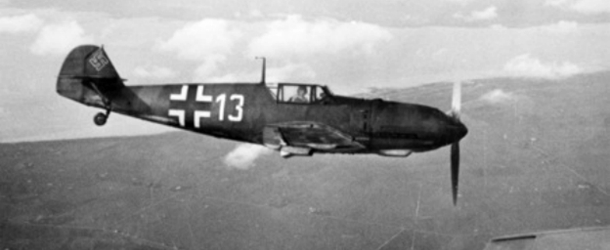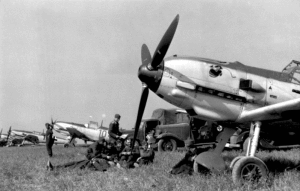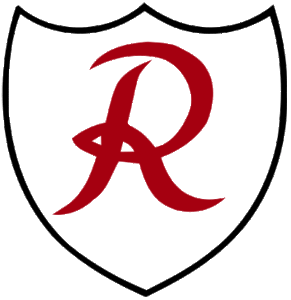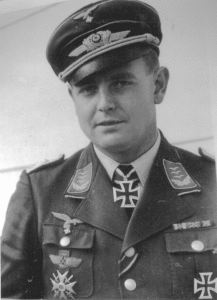The backbone of the Luftwaffe's fighter force in WW2, the Messerschmitt Bf.109 is now coming in both the WW2 Wings of Glory Battle of Britain Starter Set and in a Squadron Pack, in its E-3 version. Also called Me 109, it’s one of the most enduring fighter designs in history.
Selected in direct competition with three other vendors, the Me 109 combined the smallest, lightest airframe on the largest available engine. Its small wings allowed for speed, while high-tech slats and flaps in the wings allowed for lift at lower speeds. The plane made its public debut during the 1936 Berlin Olympics, and saw action in the Spanish Civil War.
Originally designed with a single nose-mounted 20mm cannon and 2 machine guns, when the Germans learned that the British fighters were using eight machine guns, they decided to beef up the 109’s armament. The thin wings were restrictive in this, so the best compromise was adding a single 20mm gun to each wing.
The Me 109 A, B, and C version tried various combinations of engines, guns, and other features. The “D” model actually went into serious production, although almost entirely under license. It was the main Luftwaffe fighter during the Polish invasion but very quickly replaced by the “E” model, with the E-3 being the real standard for the Blitzkrieg. The E-3 represented a step up in engine power and cooling system, wing improvements, and flying ability.
Unfortunately for the Luftwaffe, while the Me 109 performed very well in the “interceptor” role that was planned for it, in the Battle of Britain it was pressed into service as a bomber escort and even fighter bomber. Its short range greatly handicapped its abilities in these roles. Late in the Battle of Britain, a few E-4s entered service, their primary differences being an improvement to the 20mm cannon and easier production details. After E-5 and E-6 recon versions, the next step up was the E-7, first 109 to mount a drop tank. If the E-7 would have arrived sooner, it could have made a real difference in the battle’s outcome.
The Me 109 would see significant design improvements in the F series and again in the G series, finally ending the war with the lethal K series which is a recent release in Wings of Glory.
Over 30,000 Me 109s were produced during the war, amounting to more than ½ of all German fighters, and were used by all the Axis combatants, as well as Switzerland. The plane continued to be built in Czechoslovakia for a few years after the war and in Spain, where it remained in active service until 1965... the longest life span of any fighter design. Some of the Czech 109s served in the first Israeli air force - alongside of Spitfires!
Messerschmitt Bf.109 in Wings of Glory
In Wings of Glory, the Messerschmitt Bf.109 is featured in E-3 variants used by the Jagdgeschwader 2 (JG 2), two included in the Battle of Britain Starter Set and the third in the Squadron Pack. All of them come with special cards that reflect the limitations on its 20mm cannon ammo, offer the value of drop tanks.
Jagdgeschwader 2 (JG 2) was a fighter wing of the German Air Force, formed in May 1939, and named after the most famous German pilot of the First World War, Manfred von Richthofen. Its first commander was Robert Ritter von Greim, a 28-victory ace from WW1. At the time of the Battle of Britain, the unit was commanded by the remarkable Harry von Bülow-Bothkamp, one of the few men on either side to shoot down planes in both wars. He achieved six victories in WW1 and 12 in WW2. JG2 played an active role in the Battle of Britain, serving over the Channel and southern England.
After the Battle of Britain, while most of the Luftwaffe were involved in Barbarossa, JG2 and JG26 defended France and, as the main opponents of the RAF over the next few years, gained much recognition.
The two Me 109 present in the Starter Set are an aircraft used by Staffel 9 (9,/JG 2), which come with the special card “Acrobatic Pilot”, letting players choose a pilot with very good maneuvering, and one from Staffe1 1 (1,/JG 2), with the card “Technical eye” that lets players assess damage on opponents or friends.
In the Squadron Pack, the JG 2 comes with the “Sniper” card, allowing the player to select one type of damage counter based on firepower of his weapon when he fires. This model can be customized with decals in three variants: Stab.II – “7 White” or Oberleutnant Günther Dommaschk, or 1./JG 2 - Oberleutnant Otto Bertram.
Oblt. Günther Dommaschk shows us a plane noteworthy for having the symbol of a TO (Technical Officer), a black chevron and circle forward of the fuselage Balkenkreuz. Unusual for JG 2, the aircraft did not carry the unit's script 'R' emblem. The Technical Officer is charged with finding and explaining to manufacturers improvements that can be made to airplanes, guns, or anything else that helps their unit. Little is known about Dommaschk’s career. It seems he was credited with two victories.
Oblt. Otto Bertram gained his combat experiences early, being one of the most successful German pilots in the Spanish Civil War (9 victories). He was a Staffelkapitän (squadron commander) late in the Battle of Britain and Group Commander right at the end, gaining 9 victories in the Battle of Britain to end his scoring at 22. He was relieved of combat duties as the “last surviving brother” (two others died in the Luftwaffe) and spent the remainder of the war in administrative and training duties.
Information sources: "Messerschmitt Bf 109 in action Part 1", Beaman, John R. Jr. and Jerry L. Campbell (Squadron/Signal Publications),"Me 109 – Willy Messerschmitt's Peerless Fighter", Caidin, Martin, "Messerschmitt Bf 109, Versions B-E", Cross, Roy and Gerald Scarborough, "Fighter: The true story of the Battle of Britain", Deighton, Len (Castel Books), Luftwaffe Officer Career Summaries, "The Bearers of the Knight's Cross of the Iron Cross 1939–1945", Fellgiebel, Walther-Peer Forsyth, Robert Aces of the Legion Condor, Wikipedia * Bundesarchiv, Bild 101I-058-1784A-14 / Eckert, Erhardt / CC-BY-SA 3.0.













